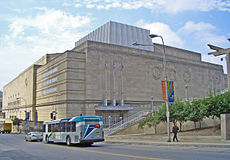Municipal Auditorium (Kansas City)
 |
|
| Location | 301 West 13th Street, Kansas City, Missouri |
|---|---|
| Coordinates | 39°05′54″N 94°35′11″W / 39.098353°N 94.586416°WCoordinates: 39°05′54″N 94°35′11″W / 39.098353°N 94.586416°W |
| Owner | City of Kansas City, Missouri |
| Operator | Kansas City, Missouri Convention and Entertainment Facilities |
| Capacity | Arena: 7,300 permanent +2,687 temporary |
| Construction | |
| Opened | 1935 |
| Renovated | 2007, 2013 |
| Construction cost | $6.5 million ($114 million in 2016 dollars) |
| Architect | Gentry, Voskamp & Neville Hoit, Price & Barnes |
| Tenants | |
|
Kansas City Kings (NBA) (1972–1974, 1979–1980) Kansas City Sizzlers (CBA) (1985–1986) UMKC Kangaroos (NCAA) (1986–2010, 2013–present) Kansas City Attack (NPSL) (1991–1992) Kansas City Roller Warriors (WFTDA) (2009–present) |
|
Municipal Auditorium is a multi-purpose facility located in Kansas City, Missouri. It opened in 1936 and features Streamline Moderne and Art Deco architecture and architectural details.
Municipal Auditorium was the first building built as part of the "Ten-Year Plan", a bond program that passed by a 4 to 1 margin in 1931. The campaign was run by the Civic Improvement Committee chaired by Conrad H. Mann. Other buildings in the plan included the Kansas City City Hall and the Kansas City branch of the Jackson County Courthouse. The plan was championed by most local politicians including Thomas Pendergast and provided Pendergast with many patronage opportunities during the Great Depression.
Municipal Auditorium replaced Convention Hall which was directly across the street and was torn down for parking in what is now called the Barney Allis Plaza.
The streamline moderne architecture was designed by the lead architectural firm of Alonzo H. Gentry, Voskamp & Neville. Gentry later completed the design of the Harry S. Truman Presidential Library and Museum after the death of the original architect, Edward F. Neild. Homer F. Neville was the lead designer for Municipal Auditorium.
Hoit, Price & Barnes, the associated architects were responsible for the design of the mechanical work (HVAC, electrical, plumbing). William L. Cassell directed that design effort. Cassell went on to start his own firm in 1933 which is still in business as W. L. Cassell & Associates, Inc.
Henry F. McElroy, the choice of Tom Pendergast and other Democratic leaders to be City Manager, announced on January 5, 1932, that the architectural services for Municipal Auditorium would be divided between the firm of Gentry, Voskamp & Neville and the firm of Hoit, Price & Barnes. In addition, Gentry's firm would take the lead. The decision was controversial and led to lengthy contract negotiations. Gentry's firm was much smaller, while Hoit, Price & Barnes were known for their work in designing the Kansas City Power and Light Building, an Art Deco skyscraper completed in 1931; the 32-story Fidelity Bank Building at 909 Walnut; Corinthian Hall; and many more Kansas City buildings and residences. Municipal Auditorium, however, was a public project and Gentry, whose father had been a prominent Democratic politician in Independence, was the preference of the Pendergast machine. Fortunately, according to Neville, there was little interference with the building's design.
...
Wikipedia
